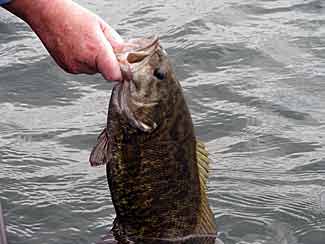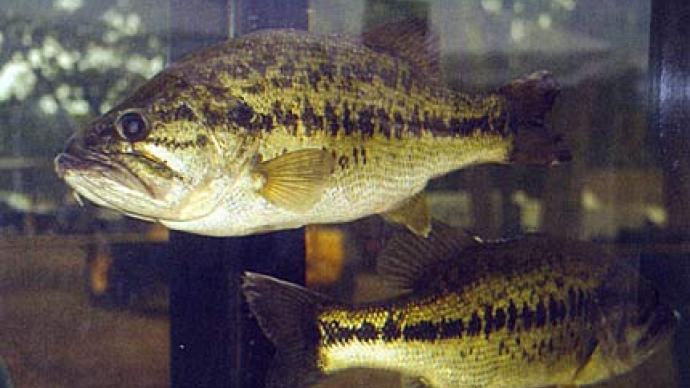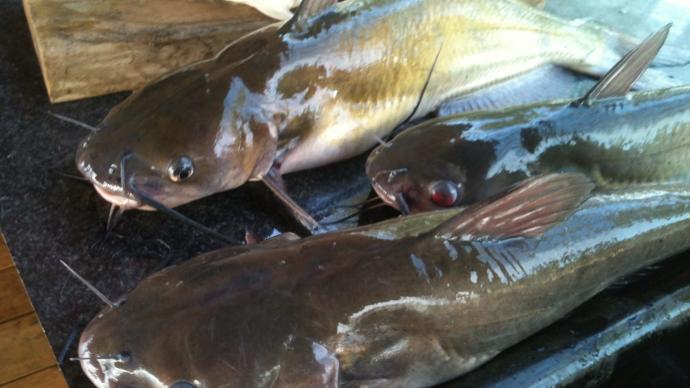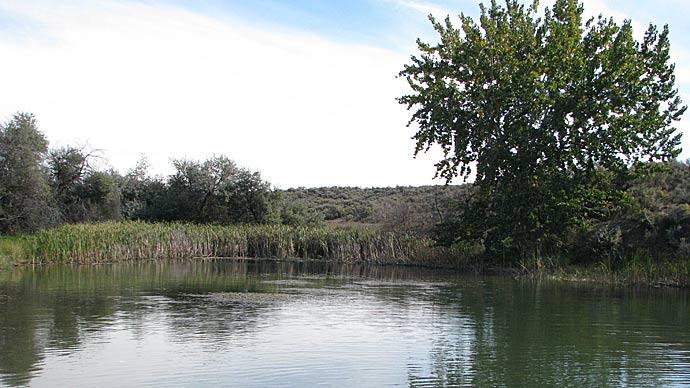
Last spring, I took my four nieces and nephews, ages 2 to 13, fishing. We were squeezed into my 16 foot Lund, and fishing a great pond that we manage for one of my good friends. Now, these kids are used to quality trout fishing. The trout ponds on their Wyoming ranch look like typical largemouth bass-bluegill ponds-clear water and lots of plants. Man, do those plants produce insects that grow big trout!
Spiny-rayed fishes were new to these kids. Even though we had a 40 mile per hour "breeze," they were having a ball catching yellow perch and a few walleyes. Then, my 13 year old nephew set the hook and nothing moved. Tyler was using a light spinning rod with 4 pound line. After a 10 minute wrestling match, he landed that smallmouth bass. Flailing and jumping at every opportunity, the smallmouth didn't want to yield. Each time it cleared the water, all four kids squealed! How big, you ask? An honest 20 incher.
I said it last issue, and I'll say it again - smallmouth bass are something special. There's a variety of management scenarios to consider using smallmouth bass.
Let's start simply. How about stocking smallmouth bass only? Believe it or not, it's certainly possible to manage smallmouth bass singly in a pond. In fact, we currently manage several ponds under such a scenario. Not much can go wrong. For pondowners who don't have time or interest for careful management, this certainly is a "safe" option. The first question I always hear is, "What will they eat?" Simple scenario, simple question, simpler answer. Smallmouth bass eat insects, crayfish...and each other. I recall the day I took one of my "buddies" (well, actually he was my boss) to a "smallmouth bass only" gravel pit fishery we manage. He tossed a 3-inch Rebel in a bass pattern. That lure outfished anything in my box 10 to 1. Did he share?
Certainly not.
My primary problem with smallmouth bass only is consistent overpopulation and "stunting" in South Dakota ponds. High density, slow growing populations develop, and few fish exceed 12 inches. A simple solution is "selective harvest." Through angling or electrofishing, we remove large numbers of sub-12 inch smallies. Remaining fish have more food resources per individual, and growth rates increase. I expect to consistently produce 18-inch smallmouths under such a management strategy in a smallmouth-only pond.
While we manage several ponds where selective harvest removes small fish to manage size structure, other pondowners like high density smallmouth bass situations. These "quantity" fisheries are great places for kids to have high catch rates for 8-12 inch fish. In fact, such waters are a nice place for kids to develop skills using a variety of artificial lures...to work on their "touch."
For our work, small fish removed are valuable. Anyone priced smallmouth bass lately? They can be moved to other waters to introduce the species, or can be used for supplemental stocking programs in waters where recruitment is low. Our fish often are used by South Dakota Game, Fish and Parks biologists for public waters, or traded to a local private fish culturist.
Here's an important point. Just because smallmouths overpopulate South Dakota hill ponds and gravel pits, this may not occur everywhere. Based on comments on the Pond Boss Forum, smallmouth bass recruitment may be more inconsistent in southern ponds. Inconsistent reproduction yields missing year classes.
Pondowners can attempt managing smallmouth bass with additional prey species. For introductory stockings, include fathead minnows with fingerling smallmouth bass. Fatheads provide a good start. However, naturally slow moving fatheads are quite vulnerable to predators and, in most cases, will disappear within a year or two. Golden shiners grow larger than fathead minnows, and may be able to persist in ponds with smallies. Especially so, if the pond has sufficient submergent aquatic plants.
I recently introduced orange spotted sunfish to one of our smallmouth bass only ponds. My graduate advisor, Dr. Steve Flickinger, suggested that idea. Orange spotted sunfish are small members of sunfish family, and a 4-incher is a big one. With smallmouths and limited reproductive ability, the shimmering iridescent blue fish with pin-head size orange spots may be a good tool for smallmouth bass management. They are native to the central United States, throughout the entire Mississippi River drainage, from North Dakota to Ohio, and Alabama westward into eastern Texas. Because of their small size, orange spotted sun-fish remain vulnerable to predation by adult smallmouth bass, and we do not expect them to overpopulate.
As you think of prey species, consider fish native to your geography. Fishery biologists in general are doing a lot less transplanting of fishes these days, and paying more attention to what occurs naturally in an area.
What about smallmouth bass with bluegills? Here's what I have been taught, and what I have conveyed for years. Smallmouth bass are not as efficient predators as largemouth bass, and a pond managed with smallmouth bass and bluegills will invariably result in a "stunted" bluegill population. Here's a typical scenario of a 3-acre hill pond in the Midwestern part of the country.
Assume submergent aquatic vegetation covers about 25% of the pond's surface area during midsummer at the peak of plant growth (by the way, such a coverage is ideal for largemouth bass-bluegill ponds in that part of the country). I would strongly recommend against a smallmouth bass-bluegill combination in such a pond. I am certain that the smallmouths would not control the reproductive capacity of bluegills in such a habitat type. Bluegills will overpopulate, leading to poor size structure (few fish over 6 inches in length). Also, hordes of small bluegills will drive a nesting male smallmouth bass crazy as hungry sunfish harass and fight to eat eggs and fry. Smallmouth bass recruitment could actually cease in the face of overabundant bluegills. This concept might just explain the inconsistent smallmouth bass recruitment in some southern ponds. If smallmouths do not reproduce and survive, they will not develop sufficient biomass (pounds per acre) to control a multi-spawning panfish species. I often use a similar method to teach students about largemouth bass and bluegill interactions in ponds. In a Midwestern pond that contains 60 pounds per acre of largemouth bass, most bass will be small (less than 12 inches), and there will be lots of predation on small bluegills. The surviving bluegills will have lots of food resources, and will grow fast and reach large size (8 inches and above). In a Midwestern pond with poor habitat for largemouth bass recruitment (perhaps muddy and no aquatic plants), there may only be 5 pounds per acre of largemouth bass. This is insufficient bass biomass to control bluegills, and sunfish almost certainly will overpopulate.
However, when I see a pond choked with overpopulated smallmouth bass, I wonder if there are some scenarios under which they might control a panfish species. I am still leery about bluegills, given their multiple spawning capabilities throughout summer months.
What about yellow perch? Yellow perch have a more streamline body shape (biologists call them fusiform) than compressed saucer shape of bluegill. Generally, predatory fish more easily capture and swallow fusiform prey species than compressed ones. When I look at one of our gravel pits where smallmouths overpopulated, I have a hard time believing smallies would not control perch reproduction. Gravel pits are steep sided, clear, with limited aquatic plant growth. Where plants grow, they drop each fall, exposing young perch in the steep sided pond.
It's possible that 75 pounds of smallmouth bass per acre (a realistic biomass) could control bluegill recruitment in such a habitat type. At this time, traditional fisheries management advice is to NOT stock smallmouth bass with a panfish species such as bluegill, yellow perch, or crappies. Any such attempts should be considered experimental.
Consider smallmouth bass with redear sunfish: Now, here's a combination that I can recommend! In fact, this combination is so good (based on my own personal opinions, of course) that I believe it's a highly overlooked option for the southern half of the country. Redear, also known as "shell-cracker," have a much lower reproductive potential than other sunfishes. I have asked biologists from across the south if they have ever seen overpopulated redear sunfish, and no one has yet been able to tell me of a single case. With their lower reproductive potential, smallmouths can keep the redears in check.
Don Gabelhouse, fisheries chief for Nebraska Game and Parks Commission, worked on this smallmouth-redear stocking combination for his graduate work at the University of Missouri. Redear are saucer shaped, speckled sunfish, with a orange-red trim on their opercular flap. Redears grow large; 10 inches is common. They are excellent table fare. The combination of a big panfish plus fun fishing for smallies makes this an ideal combination, given my personal biases!
What about smallmouth combined with largemouth bass? Start with "traditional" advice from fishery biologists. Do not try to manage a pond both largemouth bass and smallmouth bass. These two species don't play well together. Once largemouth bass gain entry to a pond or small impoundment with existing smallmouth bass, largemouths quickly out-compete smallmouths. Whether this occurs through competition between the two predators, or the more piscivorous largemouths simply eat most juvenile smallmouths produced, is not known. I suspect both.
While working in Kansas, I observed two such occurrences where largemouths gained entry to a small water body being managed with smallmouths. In both cases, I was astounded how quickly smallmouths disappeared. In a couple of South Dakota scenarios, results have not been quite as dramatic. In both cases, smallmouths actually hung on in low numbers, and did not completely disappear. However, largemouth bass now make up a big majority of black bass in these ponds.
What of smallmouth bass as "bonus" species in complex fish communities? Do not overlook opportunities to use smallmouths as a bonus, rather than primary fish species. Here are a couple of examples. I manage a 22-acre South Dakota pond that has a diverse fish community. We started the pond as a walleye-yellow perch combination, because of the pondowners interest in walleyes, and our need for a new impoundment for walleye and saugeye research.
Over time, that pond community became complex as bluegills, pumpkinseeds, smallmouth bass, and largemouth bass were added. Today, smallmouths are able to recruit a few fish yearly. Additionally, the pondowner sometimes adds a few 8-10 inch smallies from a nearby smallmouth-only pond. Low smallmouth density ensures good growth rates. We consistently produce 20 inch smallmouths in that pond, just not big numbers of fish. It's the pond I described at the start of this article.
In real world management, such situations are probably better suited for a supplemental stocking program. If a pond contains so many predators, or a variety of predator types, smallmouth may simply not be able to naturally recruit. However, adding a few subadult smallmouths may keep them as a bonus fish for anglers.
Pondowner Norm Kopecky, a Pond Boss subscriber who lives in southeastern South Dakota, actually keeps a second pond with smallmouth bass only so he can continually move a few smallies into his primary pond that contains a wide variety of predators.
If you haven't fished for smallmouth bass, it seems appropriate to finish by discussing how to catch them. Many, many magazine articles and books have been written on this subject!
Smallmouth bass are susceptible to artificial flies and lures. About the only time live bait works better seems to be at cold water temperatures. Keep in mind that hooking mortality odds rise with live bait more than artificial lures. Consider circle hooks if or when live bait is used. Mortality will be lower. Smallmouths can be caught on a wide variety of lure types: crankbaits, stick-baits, jigs, tube baits, and surface lures. Experiment with different presentations at different times of the day and seasons.
Be sure to include top water lures in your tackle menagerie. Very little in freshwater fishing is more exciting than a giant smallmouth bass exploding the surface chasing a top-running lure.
Fly fishermen drool over smallmouth bass. Try streamers or muddler minnows when fish are deep, and switch to surface flies or poppers at sunrise and sunset.
Overlooked Smallmouth bass?
Don't.
Look at the time! Our sun is moving toward the horizon. Gotta go. Smallmouths beckon.
Dr. David W. Willis is a professor in the Department of Wildlife and Fisheries Sciences, South Dakota State University in Brookings. He frequents the Pond Boss forum at www.pondboss.com and can be reached there.
Reprinted with permission from Pond Boss Magazine



